Related Research Articles
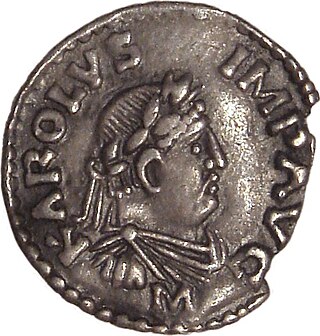
Charlemagne was King of the Franks from 768, King of the Lombards from 774, and Emperor from 800, all until his death. Charlemagne succeeded in uniting the majority of Western and Central Europe, and he was the first recognized emperor to rule Western Europe after the fall of the Western Roman Empire approximately three centuries earlier. Charlemagne's rule saw a program of political and societal changes that had a lasting impact on Europe in the Middle Ages.

Louis I, better known as Louis the Pious, also called the Fair and the Debonaire, was King of the Franks and co-emperor with his father, Charlemagne, from 813. He was also King of Aquitaine from 781. As the only surviving son of Charlemagne and Hildegard, he became the sole ruler of the Franks after his father's death in 814, a position that he held until his death except from 833 to 834, when he was deposed.

Paul the Deacon, also known as Paulus Diaconus, Warnefridus, Barnefridus, or Winfridus, and sometimes suffixed Cassinensis, was a Benedictine monk, scribe, and historian of the Lombards.
The 770s decade ran from January 1, 770, to December 31, 779.

Pepin, born Carloman, was the son of Charlemagne and King of Italy (781–810) under the authority of his father.
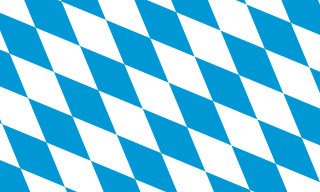
The Duchy of Bavaria was a frontier region in the southeastern part of the Merovingian kingdom from the sixth through the eighth century. It was settled by Bavarian tribes and ruled by dukes (duces) under Frankish overlordship. A new duchy was created from this area during the decline of the Carolingian Empire in the late ninth century. It became one of the stem duchies of the East Frankish realm which evolved as the Kingdom of Germany and the Holy Roman Empire.
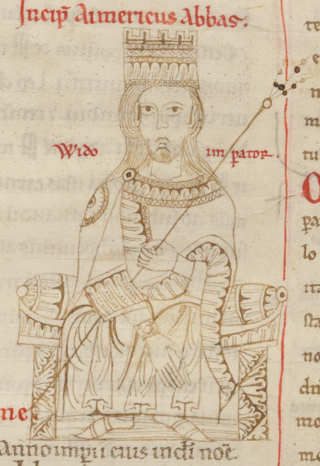
Guy III of Spoleto was the margrave of Camerino from 880 and then duke of Spoleto and Camerino from 883. He was crowned king of Italy in 889 and emperor in 891. He died in 894 while fighting for control of the Italian Peninsula.

The Patriarchate of Aquileia was an episcopal see and ecclesiastical province in northeastern Italy, originally centered in the ancient city of Aquileia, situated near the northern coast of the Adriatic Sea. It emerged in the 4th century as a metropolitan province, with jurisdiction over the Italian region of Venetia et Histria. In the second half of the 6th century, metropolitan bishops of Aquileia started to use the patriarchal title. Their residence was moved to Grado in 568, after the Lombard conquest of Aquileia. In 606, an internal schism occurred, and since that time there were two rival lines of Aquileian patriarchs: one in New Aquileia (Grado) with jurisdiction over the Byzantine-controlled coastal regions, and the other in Old Aquileia. The first line (Grado) continued until 1451, while the second line continued until 1751. Patriarchs of the second line were also feudal lords of the Patriarchal State of Aquileia. A number of Aquileian church councils were held during the late antiquity and throughout the middle ages. Today, it is an titular archiepiscopal see.

Saint Paulinus II was a priest, theologian, poet, and one of the most eminent scholars of the Carolingian Renaissance. From 787 to his death, he was the Patriarch of Aquileia. He participated in a number of synods which opposed Spanish Adoptionism and promoted both reforms and the adoption of the Filioque into the Nicene Creed. In addition, Paulinus arranged for the peaceful Christianisation of the Avars and the alpine Slavs in the territory of the Aquileian patriarchate. For this, he is also known as the apostle of the Slovenes.
Hugh was the count of Tours and Sens during the reigns of Charlemagne and Louis the Pious, until his disgrace in February 828.
Eric was the Duke of Friuli from 789 to his death. He was the eldest son of Gerold of Vinzgouw and by the marriage of his sister Hildegard the brother-in-law of Charlemagne.
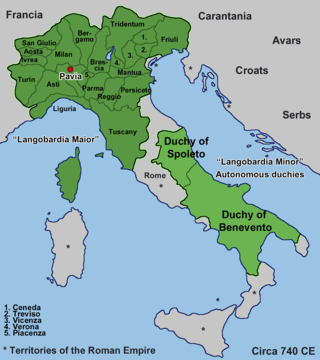
The Duchy of Friuli was a Lombard duchy in present-day Friuli, the first to be established after the conquest of the Italian peninsula in 568. It was one of the largest domains in Langobardia Major and an important buffer between the Lombard kingdom and the Slavs, Avars, and the Byzantine Empire. The original chief city in the province was Roman Aquileia, but the Lombard capital of Friuli was Forum Julii, modern Cividale.

The March of Verona and Aquileia was a vast march of the Holy Roman Empire in the northeastern Italian Peninsula during the Middle Ages, centered on the cities of Verona and Aquileia. Seized by King Otto I of Germany in 952, it was held by the Dukes of Bavaria; from 976 in personal union with the Duchy of Carinthia. The margravial regime ended with the advent of the Lombard League in 1167.
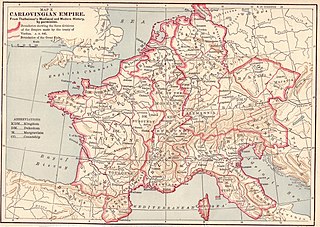
The March of Friuli was a Carolingian frontier march, established in 776 as the continuation of the Lombard Duchy of Friuli, established against the Slavs and Avars. It was ceded to the Duchy of Bavaria as the March of Verona in 952. Its territory comprised parts of modern-day Italy, Slovenia and Croatia.
Hunfrid was the Margrave of Istria and, according to some sources, Duke of Friuli from 799 to c. 804, when a Duke John was ruling Istria. He was the founder of the family called the Hunfridings.
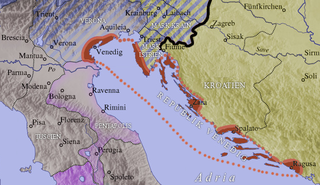
The March of Istria was originally a Carolingian frontier march covering the Istrian peninsula and surrounding territory conquered by Charlemagne's son Pepin of Italy in 789. After 1364, it was the Istrian province of the Habsburg monarchy, the Austrian Empire and Austria-Hungary.
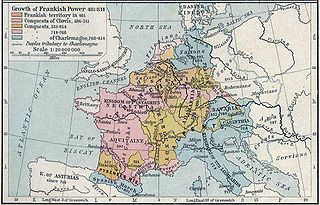
The siege of Trsat was a battle fought over possession of the town of Trsat in Liburnia, near the Croatian–Frankish border. The battle was fought in the autumn of 799 between the defending forces of Dalmatian Croatia under the leadership of Croatian duke Višeslav, and the invading Frankish army of the Carolingian Empire led by Eric of Friuli. The battle was a Croatian victory, and the Frankish commander Eric was killed during the siege.

Gerold was a franconian nobleman who served the Frankish King, Charlemagne, as Margrave of the Avar March and Prefect of Bavaria in what is now South-Eastern Germany. Gerold played a significant role in the integration of Bavaria into the Frankish Kingdom during Carolingian expansion in the late 8th, and early 9th centuries. Gerold both aided the continuity of Agilofing rule of Bavaria, as well as took steps to integrate Bavarians into the wider scope of the Frankish Kingdom. Gerold was related both to the Agilofing family, the ruling class of Bavaria, as well as the Carolingian family. The Agilofings had ruled Bavaria since Duke Garibald I in 548. Gerold was born into the Agilofings, and his sister Hildegard was married to Charlemagne in 771. From these familial connections, he was appointed Prefect of Bavaria following the deposition of Duke Tassilo III in 788. Gerold was heralded as a superb military commander, giving rise to his promotion to Prefect as a defender of the eastern border of the Frankish Kingdom. In 799, Gerold is said to have fallen in battle against the Avars, shortly after the same Avars killed his ally, Eric, Duke of Friuli, through treachery.
The Testament of Charlemagne was documented and witnessed in 811, the 43rd year of his reign. Charlemagne had intended to make a last will and testament in order to share his wealth with his daughters and the children of his concubines. Unfortunately, it was begun too late and was not finished before his death in 814. Nevertheless, three years prior, he made a division of his possessions, ratified in the presence of the faithful who were called upon as witnesses. The text of this testament is quoted from Einhard.

The War of Padua was a conflict in 1404–1405 between the Republic of Venice and the Carrarese lordship of Padua. In the power vacuum produced by the death of the Duke of Milan, Gian Galeazzo Visconti, in 1402, Francesco II da Carrara endeavored to expand into the Veneto and capture cities held by Visconti troops. These designs alarmed Venice, which allied with Milan to counter the common threat posed by the Carrarese state, and for the first time adopted a policy of direct intervention in the affairs of its hinterland.